�
Digital Camera Operating Steps and Reference Guides
Your camera includes two manuals: the “EOS D30 Camera User’s Guide” and the “Software
Starter Guide.”
EOS D30 Camera User’s Guide (This Document)
1 Prepare your camera
for use
2 Start taking pictures
3 Check your pictures
Software Starter Guide
Help
1 Install the software
from the
Canon Digital Camera
Solution Disk
2 Connect your camera
to a computer
3 Load your images onto
the computer
4 Process the images
with the software
2
I
n
t
r
o
d
u
c
t
i
o
n
Thank you for purchasing this Canon product
The Canon EOS D30 is a high-quality, high-precision, digital single-lens reflex camera with a
CMOS sensor that has a total pixel count of 3.25 million pixels.
This camera provides a full range of imaging options and functions ideal for every
photographic use, from easy, fully automatic shots for first-time users to applications for
experienced photographers.
A CompactFlash card* (CF card Type 1, 2) is used as the recording media.
Before you use your EOS D30, be sure to read this user’s guide with your camera on hand.
This will help you become more familiar with your camera, and learn how to operate it properly.
* We strongly recommend that you use a Canon CF card.
Test Shots and Warranty of Photographic Images
Before taking important pictures, we would strongly recommend that you first shoot several trial
images to make sure you are operating the camera correctly. Please note that the manufacturer
is not liable for any consequential damages arising from any malfunction of the EOS D30
camera or recording media (CF card) that results in the failure of an image to be recorded or
transferred to a computer.
Warning Against Copyright Infringement
Please note that your Canon EOS D30 camera is intended for personal use and should never
be used in a way that infringes upon or contravenes international or domestic copyright laws
and regulations. Please be advised that photographing performances, exhibitions, or
commercial properties may contravene copyright or other legal rights, even if the photograph
was taken for personal use.
G Canon and EOS are trademarks of Canon, Inc.
G Adobe and Photoshop are trademarks of Adobe Systems Incorporated.
G CompactFlash is a trademark of SanDisk Corporation.
G IBM PC/AT series computers are trademarks or registered trademarks of International
Business Machines Corporation (IBM) in the U.S.A.
G Macintosh is a trademark of Apple Computers (U.S.A.), registered in the U.S.A. and other
countries.
G Other corporate and product names used in this document are registered trademarks or
trademarks of their respective corporations.
3
�
Check Your Accessories
Before using your camera, make sure you have all the accessories shown on this and the
following page. If any are missing, contact the store where you purchased your camera.
q EOS D30 Camera
w Strap
(with eyepiece cover)
e Battery Pack BP-511
r Compact Power Adapter
CA-PS400
t DC Coupler DR-400
y CompactFlash Card
FC-16M
4
�
I
n
t
r
o
d
u
c
t
i
o
n
Check Your Accessories
u Interface Cable
IFC-200 PCU
i Video Cable VC-100
o Canon Digital Camera
Solution Disk, Adobe
Photoshop LE Disk
!0 EOS D30 Camera User’s
Guide (this document)
!1 Software Starter Guide
!2 Warranty
CameraUser’sGuide
EnglishEdition
INSTRUCTIONS
5
�
Contents
Introduction
Digital Camera Operating Steps and
Reference Guides .......................................2
Check Your Accessories.................................4
Precautions for Handling ..............................12
Quick Guide ..................................................14
Nomenclature................................................16
Conventions Used in This Manual ................22
1 Before You Begin .....................23
Replacing the Backup Battery......................24
Charging the Battery Pack............................25
Inserting and Removing the Battery Pack ...27
Inserting the Battery Pack ........................27
Removing the Battery Pack ......................28
Using a Household Power Supply............29
Mounting and Detaching a Lens ..................30
Mounting a Lens .......................................30
Detaching a Lens......................................30
Inserting a CF Card ......................................31
Removing a CF Card ................................31
File Numbering System ........................32
Basic Operation ............................................33
Main Switch...............................................33
Shutter Button ...........................................33
Using the Electronic Dials.........................34
About the LCD Monitor .............................35
Menu Functions and Settings ...................36
Setting the Date and Time....................38
Dioptric Adjustment in the Viewfinder...........40
Holding the Camera......................................40
2 Simple Picture Taking..............41
Fully Automatic Picture Taking................42
Automatic Built-in Flash ............................43
AF-Assist Light ..........................................43
Check the Image Immediately......................44
Check the Image in PLAY Mode .........44
Checking the Image After it is Taken..45
Time Images Are Displayed
for Checking..............................................46
Erasing a Recorded Image
(Single Image Erase) ................................47
Portrait Mode ...........................................48
Landscape Mode ....................................49
Close-Up Mode .......................................50
6
Sports Mode ............................................51
Night Scene Mode...................................52
3 Advanced Operations ..............53
Quality Selection...................................54
About ISO Speed .................................55
Selecting Parameters ...........................56
Parameters................................................57
AF Mode Selection ..................................58
One-Shot AF for Still Subjects ..................59
AI Servo AF for Moving Subjects..............60
AI Focus AF ..............................................60
Focusing Point Selection .......................61
Focusing On an Off-Center Subject .............62
Problem Subjects for Autofocusing ..............63
Manual Focus....................................63
INFO. Checking Camera Settings .................64
Selecting a Metering Mode ....................65
Metering Modes ............................................66
Selecting a Drive Mode ................................67
Setting the White Balance ......................68
White Balance Settings.................................69
Custom White Balance Setting.............70
Program AE..............................................72
Shutter Speed-Priority AE ........................74
Aperture-Priority AE .................................76
Checking the Depth of Field.........................77
Manual Exposure.....................................78
Automatic Depth-of-Field AE .................80
Setting Exposure Compensation ..................81
Autoexposure Bracketing.....................82
AE Lock ...................................................84
Self-timer Operation .................................85
Using the Eyepiece Cover ........................86
Bulb Exposures.............................................87
Mirror Lockup................................................88
4 Flash Photography ..................89
Using the Built-in Flash .................................90
Using the Built-in Flash
in the Easy Shooting Zone........................90
Using the Built-in Flash
in the Creative Zone..................................90
Built-in Flash Range..................................91
Flash Sync Shutter Speed and
Aperture Settings ......................................91
Red-eye Reduction ..........................93
�
FE Lock .....................................................94
Flash Exposure Compensation...........95
Flash Photography with the
EOS-Dedicated 550EX Speedlite .............96
Full Auto Flash ..........................................97
Taking Flash Pictures in Each
Shooting Mode ...........................................97
High-Speed Sync (FP Flash) ....................98
FEB (Flash Exposure Bracketing).............98
FE Lock .....................................................99
Flash Exposure Compensation...........99
Modeling Flash..........................................99
Wireless Multi-Light/E-TTL
Autoflash Photography..............................99
Using Non-Canon Flash Units ....................100
5 Playing and Erasing Recorded Images ....101
Viewing Recorded Images..........................102
Viewing a Single Image.....................102
Viewing the Index .............................102
Viewing Enlarged Images.................103
JUMP Jumping to Another Image...........103
INFO. Turning the Information Display
On and Off ..............................................104
Automated Playback of
Recorded Images (Auto playback) ........105
Rotating an Image..........................106
Protecting an Image ...........................107
Erasing Images (All Image Erase) ........108
Formatting the CF Card......................109
Print Order ..........................................110
Selecting Images for Printing..................111
Print Type ................................................113
Specifying Date Printing .........................114
Specifying File Number Printing .............115
Connecting to a TV .....................................116
Cleaning the CMOS Imaging Element ..117
6 Menu Function Settings ........119
List of Menu Functions .......................120
Custom Function Settings.......................124
7 Reference ................................130
Basic Terminology for Digital Cameras
and Digital Photography .........................130
Function Availability Table...........................134
Contents
AF Modes and Drive Modes.......................134
Exposure Warnings .....................................135
AE Lock Effects for Combinations of
Focusing Point Selection and
Metering Method.....................................135
Program Line...............................................136
Shutter Speed and
Aperture Value Readouts........................137
Troubleshooting...........................................138
Major Accessories (Sold Separately) .........140
Major Specifications....................................142
Message List...............................................145
System Map ................................................146
Index ...........................................................147
1
2
3
4
5
6
7
7
�
EOS D30
This device complies with Part 15 of the FCC Rules. Operation is subject to the following
two conditions: (1) This device may not cause harmful interference, and (2) this device
must accept any interference received, including interference that may cause undesired
operation.
Note:This equipment has been tested and found to comply with the limits for class B
digital devices, pursuant to Part 15 of the FCC Rules. These limits are designed to
provide reasonable protection against harmful interference in a residential
installation. This equipment generates, uses and can radiate radio frequency
energy and, if not installed and used in accordance with the instructions, may cause
harmful interference to radio communications. However, there is no guarantee that
interference will not occur in a particular installation. If this equipment does cause
harmful interference to radio or television reception, which can be determined by
turning the equipment off and on, the user is encouraged to try to correct the
interference by one or more of the following measures:
— Reorient or relocate the receiving antenna.
— Increase the separation between the equipment and receiver.
— Connect the equipment into an outlet on a circuit different from that to which the
receiver is connected.
— Consult the dealer or an experienced radio/TV technician for help.
Use of shielded cable is required to comply with class B limits in Subpart B of Part 15 of
FCC Rules.
Do not make any changes or modifications to the equipment unless otherwise specified
in the manual. If such changes or modifications should be made, you could be required
to stop operation of the equipment.
Canon U.S.A. Inc.
One Canon Plaza, Lake Success, NY 11042, U.S.A.
Tel No. (516)328-5600
This digital apparatus does not exceed the Class B limits for radio noise emissions from
digital apparatus as set out in the interference-causing equipment standard entitled
“Digital Apparatus”, ICES-003 of the Industry Canada.
Cet appareil numérique respecte les limites de bruits radioélectriques applicables aux
appareils numériques de Classe B prescrites dans la norme sur le matériel brouilleur:
“Appareils Numériques”, NMB-003 édictée par l’Industrie Canada.
The Mark is a directive conformity mark of
the European Community (EC).
This mark indicates that the product complies
with Australia’s EMC regulations.
Bij dit produkt zijn batterijen
geleverd. Wanneer deze leeg
zijn, moet u ze niet weggoolen
maar inleveren als KCA
8
�
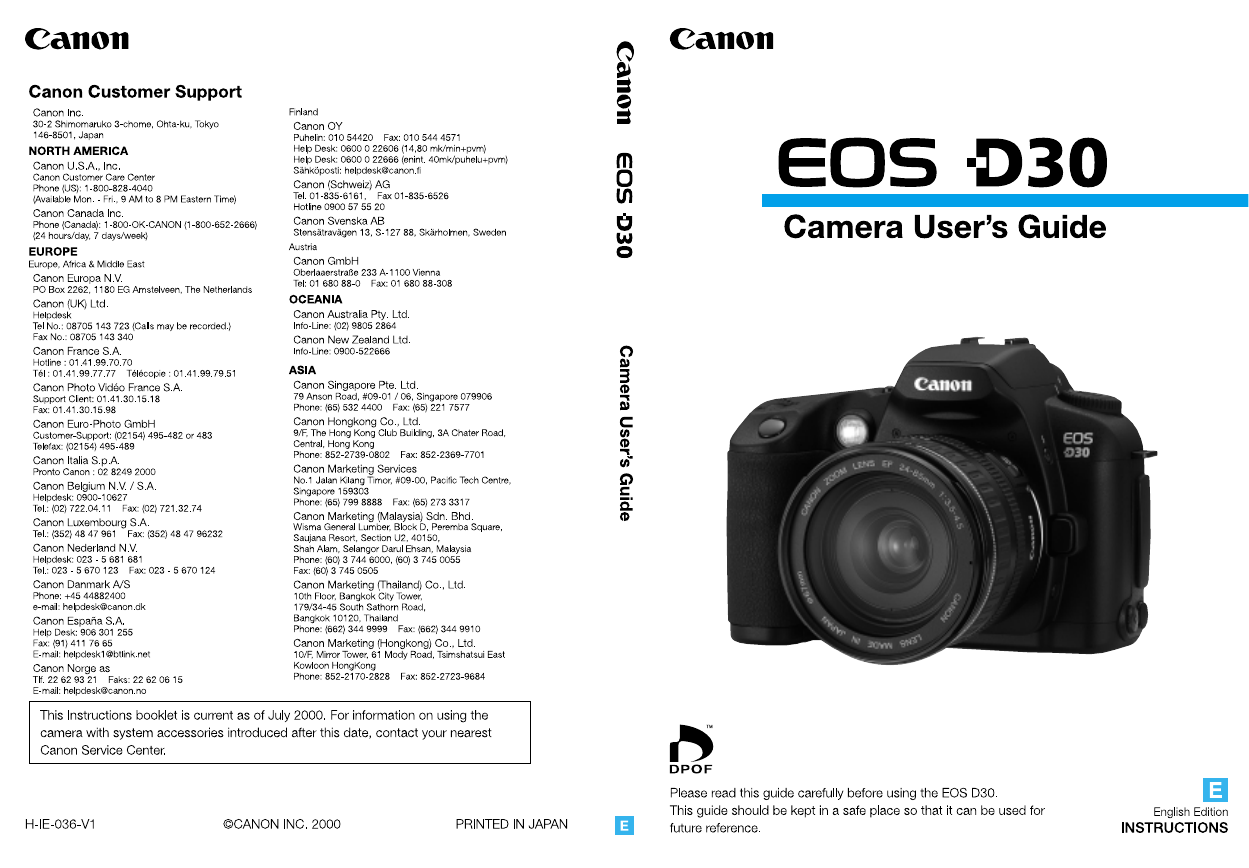

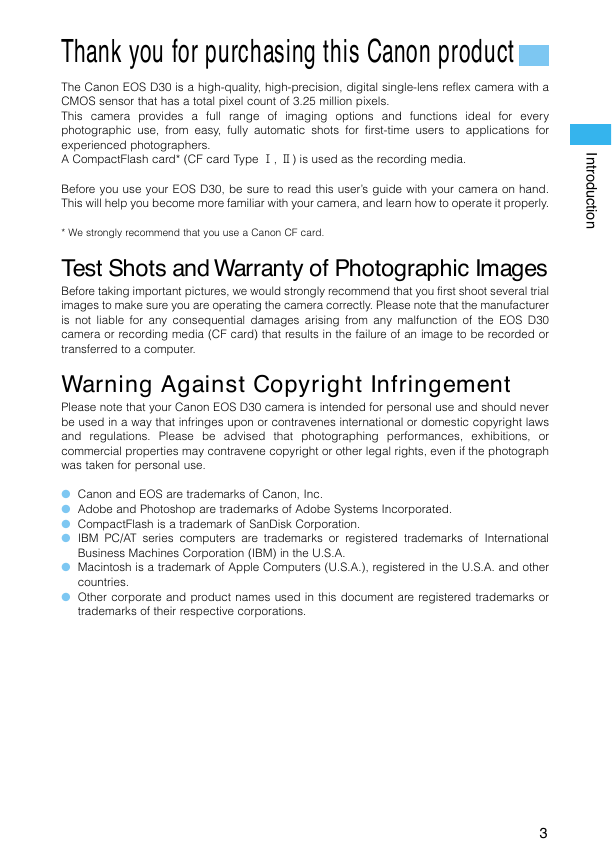
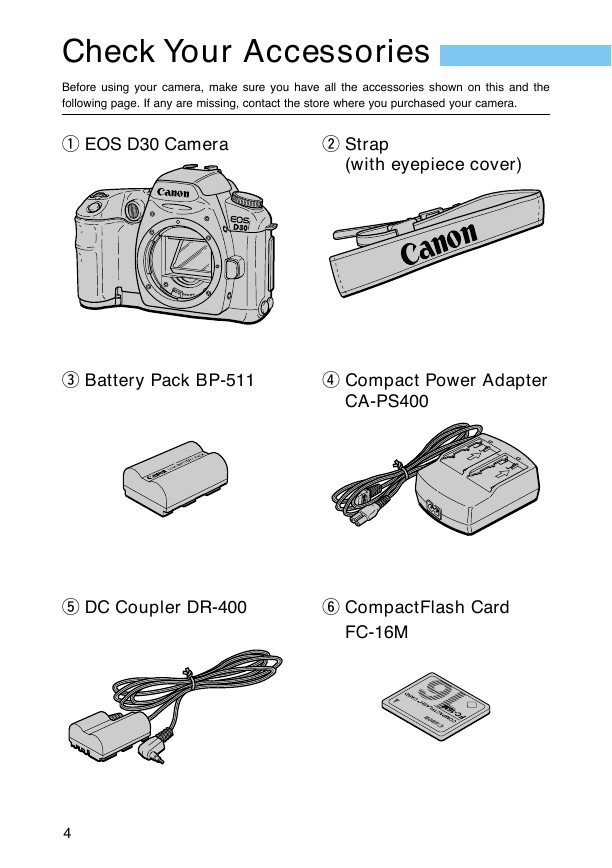

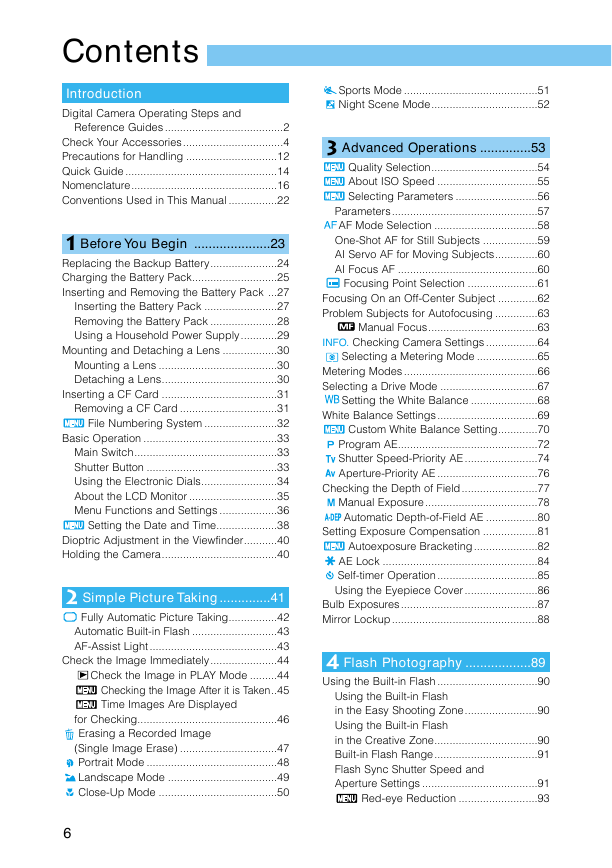
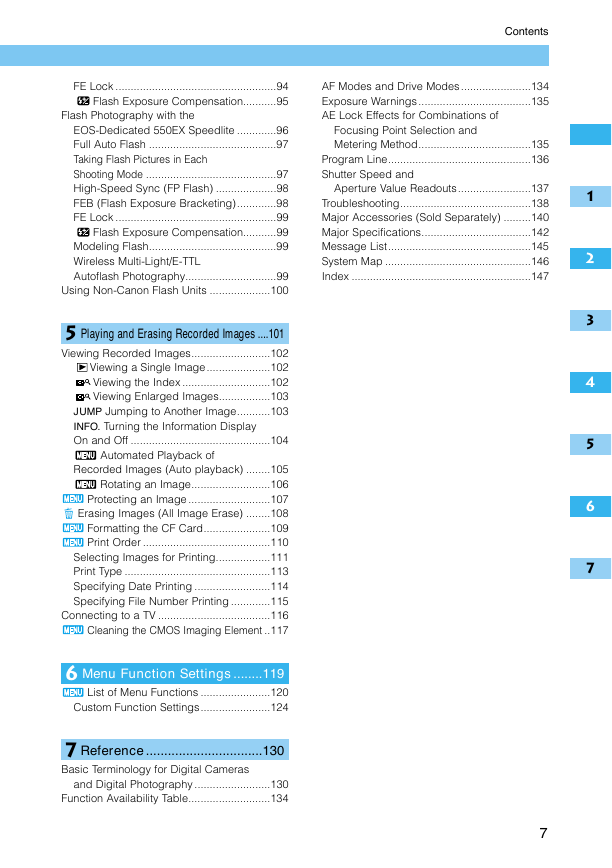
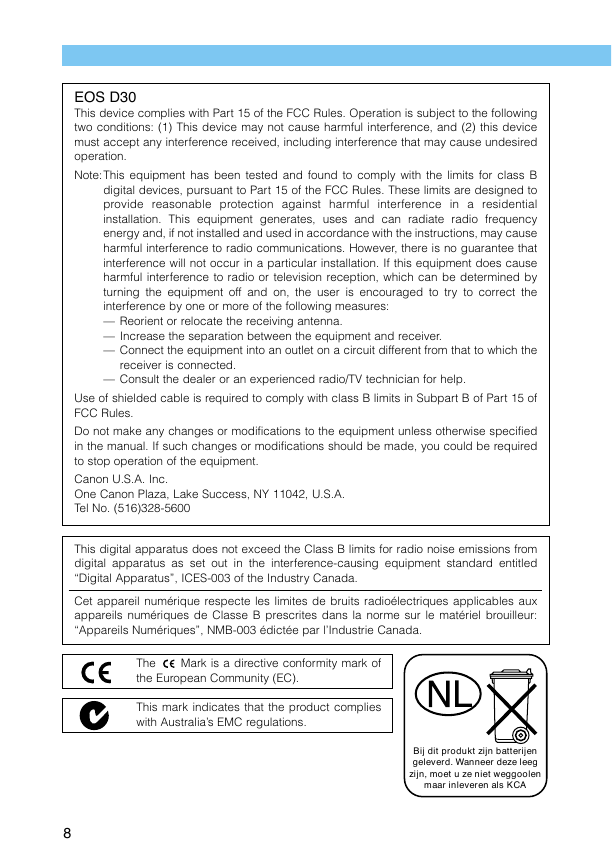








 2023年江西萍乡中考道德与法治真题及答案.doc
2023年江西萍乡中考道德与法治真题及答案.doc 2012年重庆南川中考生物真题及答案.doc
2012年重庆南川中考生物真题及答案.doc 2013年江西师范大学地理学综合及文艺理论基础考研真题.doc
2013年江西师范大学地理学综合及文艺理论基础考研真题.doc 2020年四川甘孜小升初语文真题及答案I卷.doc
2020年四川甘孜小升初语文真题及答案I卷.doc 2020年注册岩土工程师专业基础考试真题及答案.doc
2020年注册岩土工程师专业基础考试真题及答案.doc 2023-2024学年福建省厦门市九年级上学期数学月考试题及答案.doc
2023-2024学年福建省厦门市九年级上学期数学月考试题及答案.doc 2021-2022学年辽宁省沈阳市大东区九年级上学期语文期末试题及答案.doc
2021-2022学年辽宁省沈阳市大东区九年级上学期语文期末试题及答案.doc 2022-2023学年北京东城区初三第一学期物理期末试卷及答案.doc
2022-2023学年北京东城区初三第一学期物理期末试卷及答案.doc 2018上半年江西教师资格初中地理学科知识与教学能力真题及答案.doc
2018上半年江西教师资格初中地理学科知识与教学能力真题及答案.doc 2012年河北国家公务员申论考试真题及答案-省级.doc
2012年河北国家公务员申论考试真题及答案-省级.doc 2020-2021学年江苏省扬州市江都区邵樊片九年级上学期数学第一次质量检测试题及答案.doc
2020-2021学年江苏省扬州市江都区邵樊片九年级上学期数学第一次质量检测试题及答案.doc 2022下半年黑龙江教师资格证中学综合素质真题及答案.doc
2022下半年黑龙江教师资格证中学综合素质真题及答案.doc